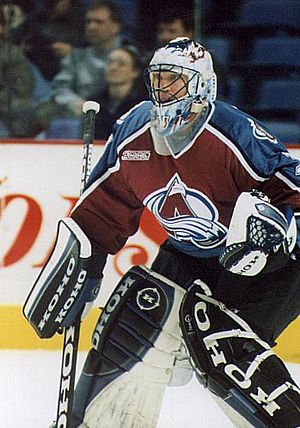Goaltender facts for kids
- For the similar jobs in other sports, see Goalkeeper.
The goaltender (often called a goalie or netminder) in ice hockey is the player whose main job is to protect their team's goal net. They stop the puck from going in, which prevents the other team from scoring. Goalies usually stay very close to their net.
Sometimes, near the end of a game, if a team is losing by just one goal, they might take their goalie off the ice. They replace the goalie with another regular player. This makes it more likely for them to score a goal. However, it also means their own net is empty, making it much easier for the other team to score.
Contents
What Does a Goaltender Do?
A goaltender's main role is to prevent the opposing team from scoring goals. They do this by blocking shots from the puck. This requires quick reflexes, good hand-eye coordination, and strong skating skills. Goalies use special equipment to protect themselves and help them make saves.
Key Skills for a Goalie
To be a great goalie, players need several important skills:
- Quick Reflexes: Pucks can travel very fast, so goalies must react in a split second.
- Agility: They need to move quickly from side to side and up and down.
- Focus: Goalies must stay focused on the puck and the game at all times.
- Puck Tracking: Following the puck's movement is crucial for anticipating shots.
- Positioning: Being in the right place at the right time helps block shots more easily.
Goaltender Equipment
Goalies wear special, heavy padding to protect them from hard shots. This equipment includes:
- Mask or Helmet: Protects the head and face.
- Chest Protector: Covers the chest, arms, and shoulders.
- Catch Glove: Worn on one hand to catch the puck.
- Blocker: Worn on the other hand to deflect shots.
- Leg Pads: Large pads that cover the legs and knees.
- Goalie Skates: Different from regular player skates, with a flatter blade.
- Goalie Stick: Wider and flatter than a regular player's stick, used for blocking and clearing the puck.
How Goalies Make Saves
Goalies use different techniques to stop the puck. A save happens when the goalie prevents a shot from entering the net.
Types of Saves
- Stick Save: Using the hockey stick to block the puck.
- Glove Save: Catching the puck with the catch glove.
- Pad Save: Blocking the puck with the leg pads.
- Body Save: Using any part of the body (protected by padding) to stop the puck.
- Butterfly Save: A common technique where the goalie drops to their knees, spreading their leg pads wide to cover the bottom of the net.
Images for kids
-
Elizabeth Wyn Wood's high relief of goaltender Turk Broda at Toronto Metropolitan University.
-
A delayed penalty call situation, in which the referee (top-left) indicates a coming penalty by raising his arm, and prepares to blow the whistle when a player from the team to be penalized (in white) touches the puck. Goaltender Jere Myllyniemi can be seen (right) rushing to the bench to send on an extra attacker.






